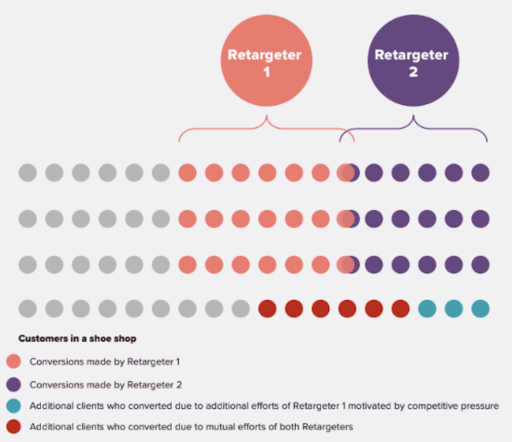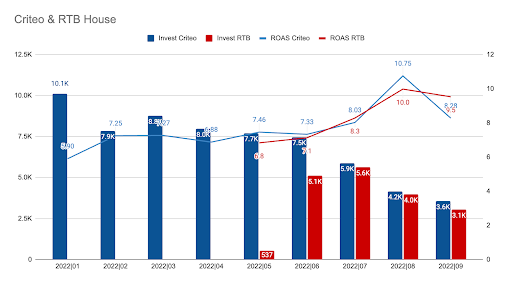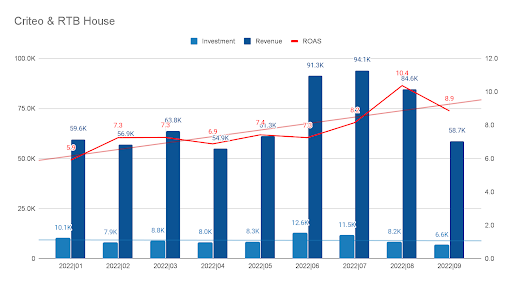SUMMARY
At one point or another in a company’s advertising career, chances are that they want to test retargeting channels to innovate themselves again. This makes sense for a lot of companies but also raises some questions. Do I need multiple RTG partners? Can’t I just have one retargeting channel? Which RTG partners are there? What is the difference between all of them? To answer all these questions, this article will take a deeper look at two of the biggest ones: Criteo & RTB House. It’ll firstly highlight why multiple rtg partners make sense, what the differences are between the Criteo & RTB House and concludes with a practical use case from clients at Semetis.
Why multiple RTG partners
A completely normal question to ask if it’s necessary to have multiple partners. Is one RTG partner not enough to cover everyone we want to reach? The simple answer is that it does add value to have multiple partners. An example to showcase it in human terms:
Imagine a shop and your only salesman is Mr. X. He is able to successfully convince some clients with his style of product presentation but not everyone.
- Next, you decided to hire an additional salesperson – Mrs Y. She has a completely different appeal and style of product presentation. Therefore, she is able to convince an entirely different segment of customers to buy.
- However, it doesn’t stop there. Some clients may buy from any salesperson so for these people, it doesn’t matter.
- There are clients that may not buy from Mr. X or Mrs. Y, separately, but having them both working together convinced them to buy.
- A final advantage is that Mr. X now also works harder because he feels he’s in a competitive market.
This works in the exact same way with the retargeting.
- RTG partner 1 targets only a specific segment of cookies.
- RTG partner 2 expands the scope of cookies that will be retargeted.
- They each have their own unique targeting algorithms and display the ads d
- ifferently across the web
- Using additional retargeters drives up the number of overall retargeted traffic and number of conversions
Visually it can be presented like this.

It’s clear that there is an added value of having both channels next to each other. It’s clear that they work differently but what we want to avoid is also that we’d target the same people multiple times via the different channels. Research of RTB House shows that overlap is minimal (only 22%). 78% of the conversions they register have only had one retargeter on their path. This makes sense since every retargeter has different technologies, algorithms, reach, and campaign strategies.
Differences Criteo & RTB house
Although both of them are being used for retargeting purposes, it’s not so easy to compare them 1-on-1 on the technical side since they both created their own algorithm. For Criteo this is based on AI and machine learning, for RTB House, it’s based on deep learning (which is also based on AI).
The main difference between machine & deep learning is that the first tries to learn from data using algorithms to perform a task without being explicitly programmed (compare it to cars being able to park on their own). Deep learning on the other hand uses a complex structure of algorithms modelled on the human brain and is considered more advanced (compare it to self-driving cars that keep learning and overwriting based on the new data).
Some other differences between the two:
Case study
Context
The client in this case is a big company, selling products both online and offline. They’re pretty advanced with their online advertising presence and had one dynamic RTG channel in the mix as well, Criteo. Every RTG partner uses their own algorithm which also makes for different results. The question then arose whether or not it could be beneficial to have multiple partners. Whether or not the two would be compatible and potentially work hand in hand. Since their algorithms work differently, they would also target and bid differently.
An experiment was set up where both ran next to each other to see if it was worth having both.
The results
The Graph below (graph 1) shows that in January only Criteo was live. End of May RTB House was launched, after a learning period of 1 month, it became fully operational as of July.

Graph 1
Since June, both ROASes have increased notably. This trend is even better visible on Graph 2 where the numbers of both channels are added together. The light blue line shows that investment was pretty consistent (trend line is straight) since January (on average between 8 & 12K). However, the ROAS trendline (light red) clearly increases. So with - on avg - a similar investment, by dividing it between the two channels, the combined ROAS & total revenue clearly improves. This would prove the added value of running them next to each other.

Graph 2
A valid counter argument however is that the summer period maybe is always a better period? Thus, if we would have continued with just one channel the results would have picked up anyway. To investigate this, we factored in historical seasonality. This showed that January also always is a good period, which would mean that the results of January (where only Criteo ran) should have been better than they were now.
Further deepdive results
At first glance you’d think they must operate in the same way because they have such similar results. It’s true that they do have very similar results. Between the months of July & September, both channels spent on average the same (15K), had a very similar ROAS (8.7 & 9), similar revenue (132-133K). However we can clearly see that on Criteo the CVR - and thus the amount of total transactions - is much higher but that it has a lower AOV. For RTB House it’s the opposite. On average, the channel has a lower CVR but a much higher AOV that compensates for all of this. This again underlines the fact that both channels truly work differently.
Table 1: period 1/7/22 - 30/9/22
Conclusion
Having multiple remarketing partners can make sense in some cases. Since every partner has developed its own algorithm it’s logical that they work differently, optimise differently, reach different people which consequently will lead to different results. The practical case shows that it can have an added value but the main important message is that this always should be adopted in a test-and-learn way to see if it makes sense for your business. We at Semetis are of course more than happy to help you with these things if you were to have any questions.



